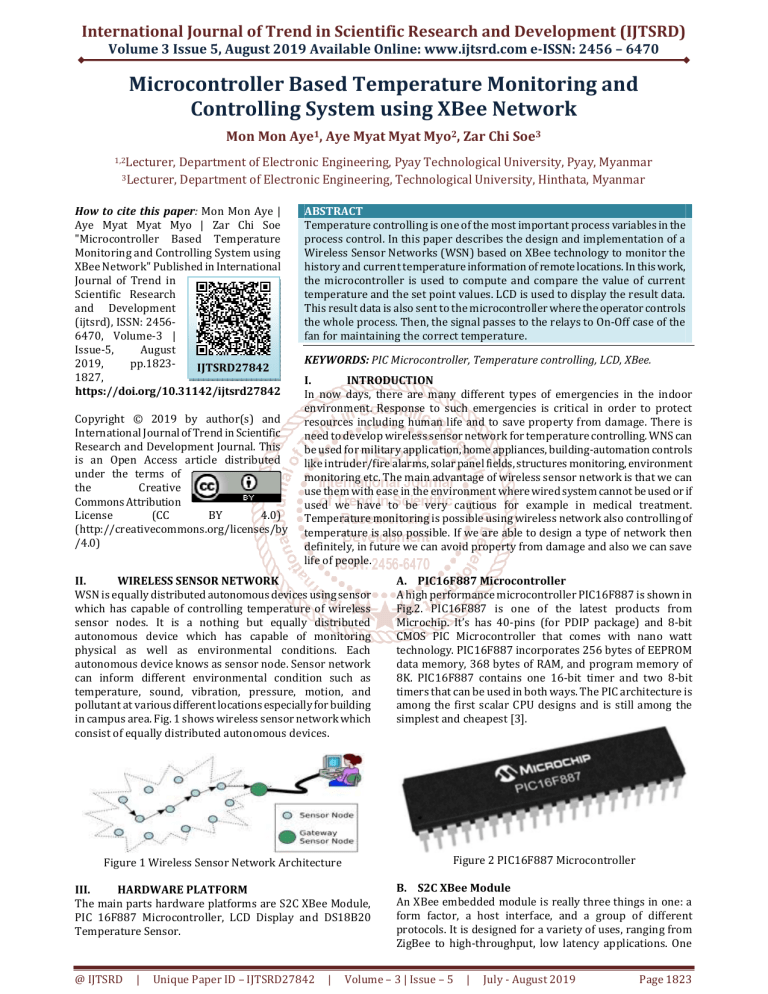
International Journal of Trend in Scientific Research and Development (IJTSRD)
Volume 3 Issue 5, August 2019 Available Online: www.ijtsrd.com e-ISSN: 2456 – 6470
Microcontroller Based Temperature Monitoring and
Controlling System using XBee Network
Mon Mon Aye1, Aye Myat Myat Myo2, Zar Chi Soe3
1,2Lecturer,
3Lecturer,
Department of Electronic Engineering, Pyay Technological University, Pyay, Myanmar
Department of Electronic Engineering, Technological University, Hinthata, Myanmar
How to cite this paper: Mon Mon Aye |
Aye Myat Myat Myo | Zar Chi Soe
"Microcontroller Based Temperature
Monitoring and Controlling System using
XBee Network" Published in International
Journal of Trend in
Scientific Research
and Development
(ijtsrd), ISSN: 24566470, Volume-3 |
Issue-5,
August
2019,
pp.1823IJTSRD27842
1827,
https://doi.org/10.31142/ijtsrd27842
Copyright © 2019 by author(s) and
International Journal of Trend in Scientific
Research and Development Journal. This
is an Open Access article distributed
under the terms of
the
Creative
Commons Attribution
License
(CC
BY
4.0)
(http://creativecommons.org/licenses/by
/4.0)
ABSTRACT
Temperature controlling is one of the most important process variables in the
process control. In this paper describes the design and implementation of a
Wireless Sensor Networks (WSN) based on XBee technology to monitor the
history and current temperature information of remote locations. In this work,
the microcontroller is used to compute and compare the value of current
temperature and the set point values. LCD is used to display the result data.
This result data is also sent to the microcontroller where the operator controls
the whole process. Then, the signal passes to the relays to On-Off case of the
fan for maintaining the correct temperature.
KEYWORDS: PIC Microcontroller, Temperature controlling, LCD, XBee.
I.
INTRODUCTION
In now days, there are many different types of emergencies in the indoor
environment. Response to such emergencies is critical in order to protect
resources including human life and to save property from damage. There is
need to develop wireless sensor network for temperature controlling. WNS can
be used for military application, home appliances, building-automation controls
like intruder/fire alarms, solar panel fields, structures monitoring, environment
monitoring etc. The main advantage of wireless sensor network is that we can
use them with ease in the environment where wired system cannot be used or if
used we have to be very cautious for example in medical treatment.
Temperature monitoring is possible using wireless network also controlling of
temperature is also possible. If we are able to design a type of network then
definitely, in future we can avoid property from damage and also we can save
life of people.
II.
WIRELESS SENSOR NETWORK
WSN is equally distributed autonomous devices using sensor
which has capable of controlling temperature of wireless
sensor nodes. It is a nothing but equally distributed
autonomous device which has capable of monitoring
physical as well as environmental conditions. Each
autonomous device knows as sensor node. Sensor network
can inform different environmental condition such as
temperature, sound, vibration, pressure, motion, and
pollutant at various different locations especially for building
in campus area. Fig. 1 shows wireless sensor network which
consist of equally distributed autonomous devices.
A. PIC16F887 Microcontroller
A high performance microcontroller PIC16F887 is shown in
Fig.2. PIC16F887 is one of the latest products from
Microchip. It’s has 40-pins (for PDIP package) and 8-bit
CMOS PIC Microcontroller that comes with nano watt
technology. PIC16F887 incorporates 256 bytes of EEPROM
data memory, 368 bytes of RAM, and program memory of
8K. PIC16F887 contains one 16-bit timer and two 8-bit
timers that can be used in both ways. The PIC architecture is
among the first scalar CPU designs and is still among the
simplest and cheapest [3].
Figure 1 Wireless Sensor Network Architecture
Figure 2 PIC16F887 Microcontroller
III.
HARDWARE PLATFORM
The main parts hardware platforms are S2C XBee Module,
PIC 16F887 Microcontroller, LCD Display and DS18B20
Temperature Sensor.
B. S2C XBee Module
An XBee embedded module is really three things in one: a
form factor, a host interface, and a group of different
protocols. It is designed for a variety of uses, ranging from
ZigBee to high-throughput, low latency applications. One
@ IJTSRD
|
Unique Paper ID – IJTSRD27842
|
Volume – 3 | Issue – 5
|
July - August 2019
Page 1823
International Journal of Trend in Scientific Research and Development (IJTSRD) @ www.ijtsrd.com eISSN: 2456-6470
nice thing about Xbee is it can do anything that ZigBee can do
(if you use the ZigBee version), but it also includes other
protocol stacks in the same form factor and host interface.
The form factor deals with a common shape and pin
configuration in the hardware. It has a 20-pin or 37-pin
socket (depending on the hardware footprint you select),
which takes up a very small amount of space on the circuit
board.
This configuration makes it easier for you to bring a new
device into the market, because if the form factor is the same,
the host interface is the same [1]. Unlike ZigBee, DigiMesh
has only one node type. All nodes can route data and are
interchangeable. Fig. 3 is S2C XBee Module.
Figure 5 LCD Display
E. Interfacing Relay with PIC Microcontroller
In this system, to ON/OFF fan or heater, relay is used. A relay
is an electromagnetic switch which is used to switch High
Voltage/Current using low power circuit. Relay are used
where it is necessary to control a circuit by a separate lowpower signal, or where several circuits must be controlled
one signal [4]. Fig. 6 shows Relay Design Circuit.
Figure 6 Circuit Design of Relay
Figure 3 S2C XBee Module
C. DS18B20 Temperature Sensor
Fig. 4 shows DS18B20 temperature sensors. The DS18B20 is
a small temperature sensor with a built in 12bit ADC. It can
be easily connected to an Arduino digital input. The sensor
communicates over a one-wire bus and requires little in the
way of additional components. It requires only the data pin
connected to the microcontroller with a pull up resistor and
the other two pins are used for power. The temperature
value measured by the sensor will be stored in a 2-byte
register inside the sensor. This data can be read by the using
the 1- wire method by sending in a sequence of data.
DS18B20 has a unique 64-bit serial code, which allows
multiple DS18B20s to function on the same 1-Wire bus. The
DS18B20 has an operating temperature range of -55°C to
+125°C and the accuracy is ±0.5°C over the range of -10°C to
+85°C [7].
F. X-CTU SOFTWARE
XCTU is a free multi-platform application that enables
developers to manage Digi radio frequency (RF) modules
through a simple-to-use graphical interface. The application
includes embedded tools that make it easy to set up,
configure, and test Digi RF modules. To use XBee module in
this system, we must configure this XBee, first. XCTU
software is most reliable to configure this XBee module [6].
Fig. 7 shows the XCTU Software.
Figure 7. XCTU Software
IV.
SYSTEM IMPLEMENTATION
The implementation of the proposed XBee wireless sensor
network includes: End Node and Base Station hardware and
software Implementation.
Figure 4 DS18B20 Digital Temperature Sensor
D. Liquid Crystal Display (LCD)
A 2x16 LCD (1602A) is shown in Fig. 5 with 4-bit interface
mode has been chosen to display the sensor readings
received from end nodes.
@ IJTSRD
|
Unique Paper ID – IJTSRD27842
|
A. Base Station (Master Control) Implementation
Fig. 8 shows the block diagram of Base Station. In this
station, the user needs to define the desired value of
temperature by using the setting key. And then the base
station has been implemented to collect end nodes sensor
information and display this information on LCD. The MCU
has been the main controller of base station operation. The
MCU receives the end nodes sensors information from the
Coordinator XBee module. The XBee module has been
connected to MCU through UART1 interface.
Volume – 3 | Issue – 5
|
July - August 2019
Page 1824
International Journal of Trend in Scientific Research and Development (IJTSRD) @ www.ijtsrd.com eISSN: 2456-6470
temperature is not greater than, the heater relay will ON and
fan will OFF. In this stage, the LCD will display new
temperature data and end-device will send that data to
microcontroller. Finally, the microcontroller sets this new
temperature and keeps this condition until the new
conditions appear.
Figure 8 Block Diagram of Base Station
B. End Node (Slave Controller) Implementation
Fig. 9 shows the structure of proposed XBee end node. End
node has the sensor that senses the environmental
information and sends this information to the
microcontroller which processes the information and
displays the data on LCD. Then the processed information
has been sent to the XBee module. The XBee module sends
the information to the coordinator.
Figure 10 Flow Chart of Master Control
Figure 9 Block Diagram of Slave Controller
The XBee has been connected to PIC16F887 through UART
interface. And then, the desire data will be resend from
coordinator XBee to slave and the PIC controls the system to
ON or OFF fan or heater. If the real temperature is higher
than the desire temperature from setting key, the fan will ON
and if not the fan will OFF. As a power source, each end node
has been provided by DC power using 9V battery and
because that MCU works on DC 5V and XBee module works
on DC 3.3V, voltage regulators has been used.
V.
SYSTEM OPERATION
The system operation initializes from base station. The base
station sends a request to end node. In this station, the user
can choose increment or decrement of the temperature.
After pressing the setting key, the changed temperature will
display on LCD and send to microcontroller. If an end node
receives the request, this node will get the information from
temperature sensor and upload it to the slave XBee module.
The XBee module sends this information to the base station
coordinator. Once the microcontroller of base station gets
the end nodes information from the XBee module through
UART interface, the MCU processes the information received
from end node and sends that information to the LCD
module. The LCD will display the received sensor readings.
The data that end-device received is real temperature. When
real temperature is greater than the desire temperature, the
fan will ON and heater relay will OFF. The desire
temperature is changed by other side, coordinator. If the real
@ IJTSRD
|
Unique Paper ID – IJTSRD27842
|
Fig. 10 and Fig. 11 show the flowcharts for Base Station and
End Nodes operation. Fig. 12 and Fig. 13 show selections of
End-device module and coordinator module. Fig. 14 the final
Xbee coordinator and end-device System hardware design.
Figure 11 Flow Chart of Slave Control
Volume – 3 | Issue – 5
|
July - August 2019
Page 1825
International Journal of Trend in Scientific Research and Development (IJTSRD) @ www.ijtsrd.com eISSN: 2456-6470
Figure 12 Selected End-device Module
Figure 16 Sensor Senses the Real Room Temperature and
Shows on LCD
Figure 13 Selected Coordinator Modules
Figure 17 Fan Turns On
When the sensor is getting heat, the ambient temperature
may be unstable that is it can rise the room temperature and
sends data to the coordinator. Now, real temperature is
higher than the desire data, fan will turn on. This is shown in
Fig 17.
On the testing, the desired temperature value would be
increased to 30˙C in coordinator section. Fig. 18 shows that
the setting key adjusted to new temperature.
Figure 14 Final Xbee Coordinator and End-device System
Hardware Design
VI.
TEST AND RESULTS
When the user wants to change the room temperature, the
setting key is used for changing. Fig. 15 shows the
temperature adjusting by Setting Key in Coordinator section.
Fig. 16 shows the real room temperature from the sensor
and shows on LCD.
Figure 18 Setting Key adjusted to new temperature
Figure 15 Temperature Adjust by Setting Key in
Coordinator
@ IJTSRD
|
Unique Paper ID – IJTSRD27842
|
When the new set value can be sensed on the end device, the
setting key change the temperature that is higher than the
actual room temperature, the fun will turn OFF as shown in
Fig. 19.
Volume – 3 | Issue – 5
|
July - August 2019
Page 1826
International Journal of Trend in Scientific Research and Development (IJTSRD) @ www.ijtsrd.com eISSN: 2456-6470
ACKNOWLEDGEMENT
I would wish to acknowledge the many colleagues at Pyay
Technological University who have contributed to the
passing this research paper.
REFERENCES
[1] https://www.link-labs.com/blog/zigbee-vs-xbee
[2] Stefan Posland, Ubiquitous Computing: Smart Devices,
Environments and Interactions, Wiley, 2009
[3] https://www.eleprocus.com/pic-microcontroller
[4] Wireless Sensor Network Research
http://www.sensornetworks.org
Group,
[5] Arduino, http://arduino.cc/.
Figure 19 Fan Turns OFF
VII.
CONCLUSION
In this paper, a prototype of an embedded wireless sensor
network has been built based on PIC microcontrollers and
XBee module. The environmental temperature monitoring
has been considered in this system to demonstrate the
capability of applying the system. The system has the
character of wireless on wiring to remove the limitation of
traditional wired network system for any kind of remote
conditions monitoring. Wireless technology has already
become an important application which usually integrated to
a wide range of device and other technologies. This system
uses the XBee as the wireless module. The combination of
low-cost hardware, very good radio performance makes
XBee a competitive choice on the wireless market.
@ IJTSRD
|
Unique Paper ID – IJTSRD27842
|
[6] Introduction
to
XCTU
https://www.digi.com/products/xbee-rfsolutions/xctu- software/xctu
Software
[7] W. Dargie, C. Poellabauer, and Wiley Inter Science
(Online service), Fundamentals of wireless sensor
networks theory and practice. Chichester, West Sussex,
U.K.; Hoboken, NJ: Wiley, 2010.
[8] Digi International Inc, XBee ZNet2.5/XBee-PRO ZNet2.5
OEM RF Modules, Product Manual v1.x.4x - ZigBee
Protocol For OEM RF Module Part Numbers: XB24BxIT-00x,Digi International Inc.11001 Bren Road East
Minnetonka, MN 55343877 912-3444 or 952 912-3444
http://www.digi.com
Volume – 3 | Issue – 5
|
July - August 2019
Page 1827





